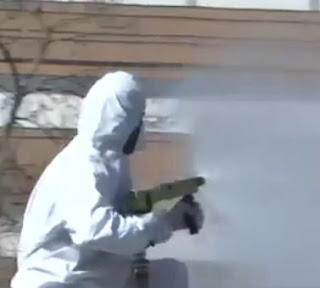Worker Safety and Chemical Disinfectants
 |
| Using Disinfect Spray in Iran |
With the widespread concern over the coronavirus, more people are talking about and using chemical disinfection.
From a worker safety perspective here are some basic things to know about disinfection.
Disinfectants are intended to kill microorganisms. They may also be hazardous to humans and the environment, especially when concentrated.
The use of disinfectants can impact worker safety both directly and indirectly. Direct exposure to a hazardous chemical may result when a disinfectant is used inappropriately (for example, if a worker fails to wear personal protective equipment when diluting a concentrated chemical).
Indirect impact on worker safety can occur as a result of an exposure to viable pathogens when an inappropriate product is selected (for example, if a disinfectant or product that kills vegetative bacteria only was used against a non-enveloped virus), or if an effective product is used inappropriately (for example, diluted too much).
Workers should learn about the products required for disinfection of the agents with which they will be working, including recommended directions for use (including application method, contact time, personal protective equipment, precautions, first aid, and disposal) as well as chemical characteristics (such as the toxicity, chemical compatibility, storage stability, active ingredient identity and concentration).
Much of this information is provided on the product label. Some manufacturers may also be willing to share reports of efficacy testing for their products.
Given that product effectiveness depends on the active ingredient(s) as well as the identity and concentration of other ingredients in the formulation, it is difficult to make generalisations about contact times and concentrations needed to kill specific pathogens. Users should therefore choose a registered product, read the label before using, and follow the directions for use carefully.
Manufacturers are permitted to test their own products to demonstrate label claims. Therefore, it is prudent to consider whether manufacturers’ claims are consistent with the recognised characteristics of the active ingredient and with current research published in peer-reviewed scientific journals such as the Journal of Infection Control and Hospital Epidemiology.
When selecting a disinfectant, check the label for a Drug Identification Number (DIN XXXXXXXX). Drug Identification Number (DIN): A DIN is a computer-generated eight-digit number assigned by Health Canada to a drug product which has been granted market authorization in accordance with the Food and Drugs Act and Regulations. The DIN uniquely identifies the product and must appear on the marketed product label for all drugs authorized for sale in Canada.
Users of disinfectants should be aware of potential incompatibilities with other chemicals. For example, chlorine-releasing compounds should never be mixed with other chemicals because doing so may cause the production of toxic chlorine gas.
In a future post we will:
- look at the definition of words commonly used when talking about disinfection;
- discuss the types of chemical disinfectants and the pros and cons of using each;
- examine the factors that affect germicidal action.
Paul Langan
Paul worked for 25 years in occupational health and safety in the federal government. Part of his responsibilities was to develop and implement a laboratory safety manual. Chemical Disinfectants was a chapter in that manual.
#coronavirus #disinfectants #safety

